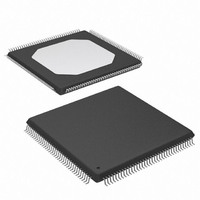XC3S250E-4TQG144I Xilinx Inc, XC3S250E-4TQG144I Datasheet - Page 49

XC3S250E-4TQG144I
Manufacturer Part Number
XC3S250E-4TQG144I
Description
FPGA Spartan®-3E Family 250K Gates 5508 Cells 572MHz 90nm (CMOS) Technology 1.2V 144-Pin TQFP
Manufacturer
Xilinx Inc
Series
Spartan™-3Er
Datasheet
1.XC3S100E-4VQG100C.pdf
(233 pages)
Specifications of XC3S250E-4TQG144I
Package
144TQFP
Family Name
Spartan®-3E
Device Logic Cells
5508
Device Logic Units
612
Device System Gates
250000
Number Of Registers
4896
Maximum Internal Frequency
572 MHz
Typical Operating Supply Voltage
1.2 V
Maximum Number Of User I/os
108
Ram Bits
221184
Number Of Logic Elements/cells
5508
Number Of Labs/clbs
612
Total Ram Bits
221184
Number Of I /o
108
Number Of Gates
250000
Voltage - Supply
1.14 V ~ 1.26 V
Mounting Type
Surface Mount
Operating Temperature
-40°C ~ 100°C
Package / Case
144-LQFP
Lead Free Status / RoHS Status
Lead free / RoHS Compliant
For Use With
813-1009 - MODULE USB-TO-FPGA TOOL W/MANUAL
Lead Free Status / RoHS Status
Lead free / RoHS Compliant
Available stocks
Company
Part Number
Manufacturer
Quantity
Price
Company:
Part Number:
XC3S250E-4TQG144I
Manufacturer:
XILINX
Quantity:
1 670
Company:
Part Number:
XC3S250E-4TQG144I
Manufacturer:
XILINX
Quantity:
284
Company:
Part Number:
XC3S250E-4TQG144I
Manufacturer:
Xilinx Inc
Quantity:
10 000
Part Number:
XC3S250E-4TQG144I
Manufacturer:
XILINX/赛灵思
Quantity:
20 000
Table 28: DLL Signals
Delay-Locked Loop (DLL)
The most basic function of the DLL component is to elimi-
nate clock skew. The main signal path of the DLL consists of
an input stage, followed by a series of discrete delay ele-
ments or steps, which in turn leads to an output stage. This
path together with logic for phase detection and control
forms a system complete with feedback as shown in
Figure
using a counter-based delay line.
The DLL component has two clock inputs, CLKIN and
CLKFB, as well as seven clock outputs, CLK0, CLK90,
CLK180, CLK270, CLK2X, CLK2X180, and CLKDV as
DS312-2 (v3.8) August 26, 2009
Product Specification
CLKIN
CLKFB
CLK0
CLK90
CLK180
CLK270
CLK2X
CLK2X180
CLKDV
Signal
41. In Spartan-3E FPGAs, the DLL is implemented
R
Direction
Output
Output
Output
Output
Output
Output
Output
Input
Input
CLKFB
CLKIN
RST
Receives the incoming clock signal. See
external inputs to a DCM.
Accepts either CLK0 or CLK2X as the feedback signal. (Set the CLK_FEEDBACK
attribute accordingly).
Generates a clock signal with the same frequency and phase as CLKIN.
Generates a clock signal with the same frequency as CLKIN, phase-shifted by 90°.
Generates a clock signal with the same frequency as CLKIN, phase-shifted by 180°.
Generates a clock signal with the same frequency as CLKIN, phase-shifted by 270°.
Generates a clock signal with the same phase as CLKIN, and twice the frequency.
Generates a clock signal with twice the frequency of CLKIN, and phase-shifted 180°
with respect to CLK2X.
Divides the CLKIN frequency by CLKDV_DIVIDE value to generate lower frequency
clock signal that is phase-aligned to CLKIN.
Figure 41: Simplified Functional Diagram of DLL
Delay
1
Delay
2
Detection
Control
Phase
www.xilinx.com
Delay
n-1
described in
neously. Signals that initialize and report the state of the
DLL are discussed in
The clock signal supplied to the CLKIN input serves as a
reference waveform. The DLL seeks to align the rising-edge
of feedback signal at the CLKFB input with the rising-edge
of CLKIN input. When eliminating clock skew, the common
approach to using the DLL is as follows: The CLK0 signal is
passed through the clock distribution network that feeds all
the registers it synchronizes. These registers are either
internal or external to the FPGA. After passing through the
Delay
n
Description
Table
Table
30,
28. The clock outputs drive simulta-
Status
Table
DS099-2_08_041103
CLK0
CLK90
CLK180
CLK270
CLK2X
CLK2X180
CLKDV
LOCKED
31, and
Logic.
Functional Description
Table 32
for optimal
49

















